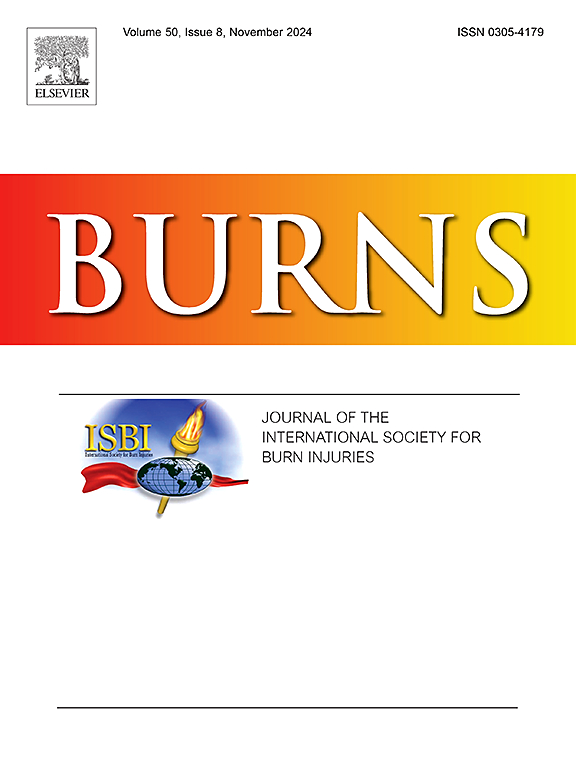Effects of black mulberry, chokeberry, and elderberry extracts on the healing of burn wounds
IF 3.2
3区 医学
Q2 CRITICAL CARE MEDICINE
引用次数: 0
Abstract
Background
In the burn affected area of the skin, the progression or deepening of wounds is related to oxidative stress. Especially in the highly susceptible stasis zone, tissues survive to the extent that they can cope with oxidative stress.
Objective
This study investigated the potential of extracts (E) derived from the fruits (F) and leaves (L) of elderberry (E), chokeberry (C), and black mulberry (M), which are rich in antioxidant properties, to enhance the recovery of the stasis zone in burn wounds.
Methods
The study employed a sample size of 56 healthy rats. The comb burn model was used. The rats were administered the extracts via gastric gavage for a period of 21 days. Histological examination and biochemical analyses were conducted on biopsies taken from the stasis zone on the 3rd, 7th, and 21st days of the study. Photography was performed for macroscopic evaluations. The histological assays included the evaluation of inflammatory cell infiltration, reepithelialization, and collagenization, as well as immunohistochemical analysis of vascular endothelial growth factor (VEGF). Bioassays pertaining to the enzymatic activities of catalase, superoxide dismutase, glutathione peroxidase, and malondialdehyde (MDA) levels were performed.
Results
In macroscopic evaluation, a significant difference was found between the groups in terms of stasis area (F=3.58, p2< 0.001). Post-hoc analyses showed that there was a significant difference between CFE-ELE, EFE-Burn, ELE-Burn and MLE-Burn groups in terms of stasis zones (p < 0.05). However, the difference between the groups according to time was not significant (F=1.36, p = 0.16). At the end of the 21-day experiment, inflammatory cell infiltration was higher in the burn group compared to the other groups, but similar to the CFE group. Re-epithelialization was similar in the burn group compared to the fruit extract groups and significantly lower compared to the leaf extract groups. Furthermore, a significant increase in collagenization and VEGF immunoreactivity was observed in all treatment groups compared to the burn group (p < 0.05). However, no significant difference was detected between the treatment groups. The treatment groups presented a notable reduction in MDA levels in comparison to the burn group (p < 0.001).
Conclusion
This study demonstrated the efficacy of fruit and leaf extracts in burn healing. Histological examination revealed that leaf extracts exhibited superior healing effects compared to fruit extracts. These results suggest that bioactive components in fruits and leaves may have different biological effects.
求助全文
约1分钟内获得全文
求助全文
来源期刊

Burns
医学-皮肤病学
CiteScore
4.50
自引率
18.50%
发文量
304
审稿时长
72 days
期刊介绍:
Burns aims to foster the exchange of information among all engaged in preventing and treating the effects of burns. The journal focuses on clinical, scientific and social aspects of these injuries and covers the prevention of the injury, the epidemiology of such injuries and all aspects of treatment including development of new techniques and technologies and verification of existing ones. Regular features include clinical and scientific papers, state of the art reviews and descriptions of burn-care in practice.
Topics covered by Burns include: the effects of smoke on man and animals, their tissues and cells; the responses to and treatment of patients and animals with chemical injuries to the skin; the biological and clinical effects of cold injuries; surgical techniques which are, or may be relevant to the treatment of burned patients during the acute or reconstructive phase following injury; well controlled laboratory studies of the effectiveness of anti-microbial agents on infection and new materials on scarring and healing; inflammatory responses to injury, effectiveness of related agents and other compounds used to modify the physiological and cellular responses to the injury; experimental studies of burns and the outcome of burn wound healing; regenerative medicine concerning the skin.
 求助内容:
求助内容: 应助结果提醒方式:
应助结果提醒方式:


